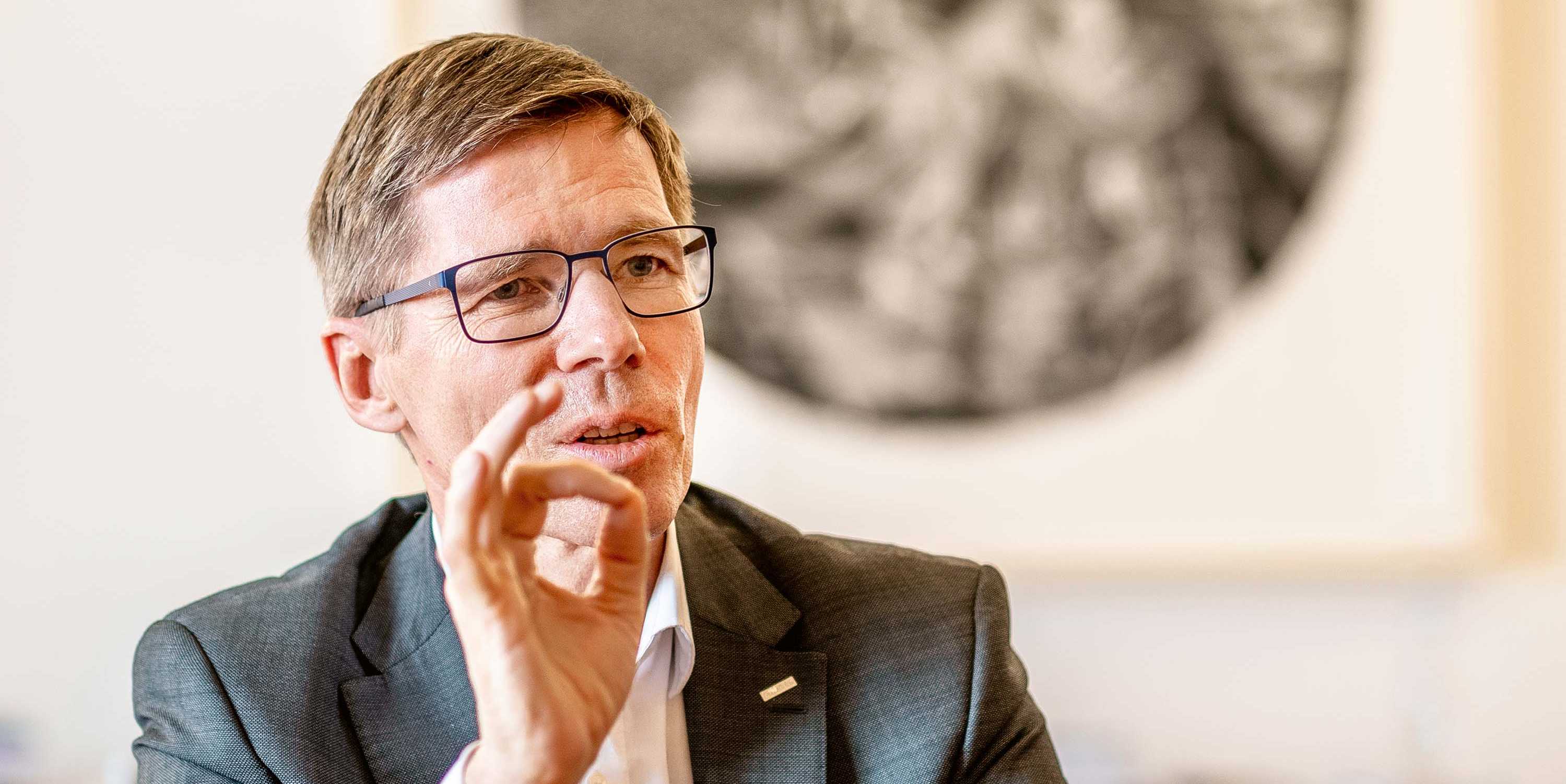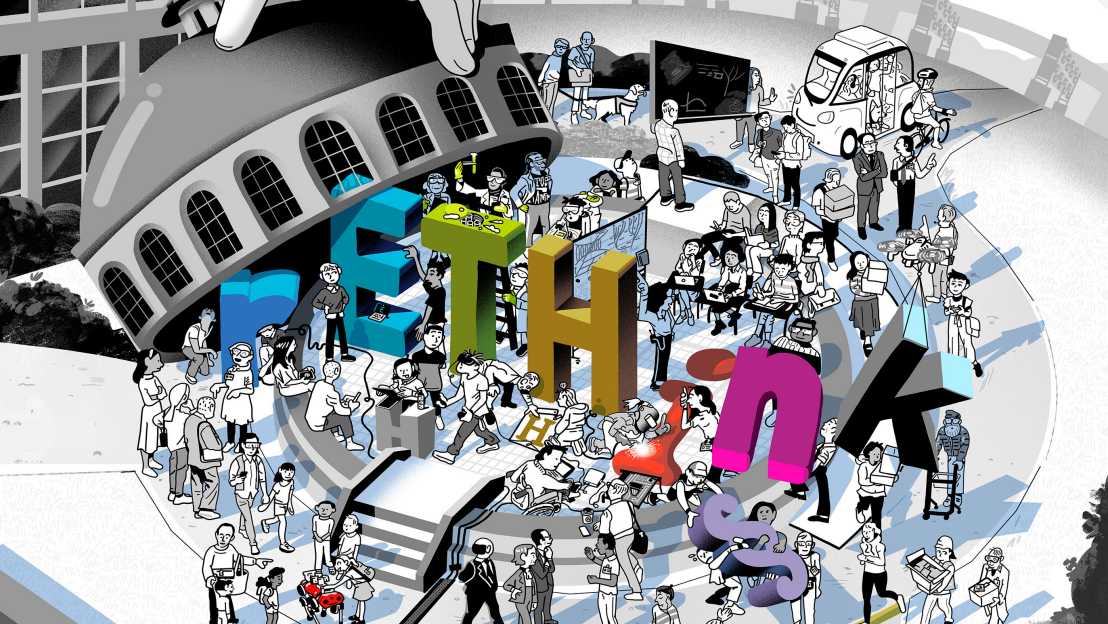“rETHink is going to increasingly make itself felt in everyday life at ETH”
rETHink seems to have quieted down in recent months – but appearances can be deceiving. The project’s six workstreams have been hard at work fleshing out solutions for the future of the university. Smaller projects have already been implemented, and decisions have been made regarding the trajectory of bigger changes, says President Joël Mesot.

Mr Mesot, after taking office as President of ETH, you launched the rETHink project with the aim of ensuring that the university and its members can retain their autonomy and freedom. This touches on topics like ownership, leadership and feelings of affiliation with ETH. Things seem to have slowed down, however, following initial broad-based discussions about the university’s values and the presentation of areas for action. Is the project stumbling a bit?
Joël Mesot: It’s true that there hasn’t been much news published about rETHink recently. Paradoxically, this is because the project is taking shape, and the participants are now developing concrete solutions. Before we introduce these new ideas to all of ETH, we’d like to sound them out with stakeholder groups and in various participatory bodies.
In a nutshell, could you tell us: What are the main issues that the project is currently working on? What solutions are starting to emerge?
Joël Mesot: Let’s take the discussion about values that you mentioned. You’ll recall that “excellence” in particular proved to be not uncontroversial. Over the past few months, the values debate has continued apace in various committees and working groups. AVETH in particular has contributed immensely here. Now there’s a reworked set of values that goes far beyond what was originally proposed. Today, our values are integrated into an overall model that also includes ETH Zurich’s vision and mission. “Excellence” is no longer included. We acknowledged voices in the ETH community that didn’t want to describe themselves as excellent, even if they do deliver excellent work. Striving for excellence is now codified in our mission statement. At the same time, we make a connection to our obligations towards society, which striving towards excellence helps us fulfil.
And what about the other values?
Openness, responsibility, team spirit and diversity weren’t terribly controversial, even if we did get a few questions here and there about whether they were precise enough. Some people felt that values such as respect were missing. These ongoing discussions have been enhanced from a completely different angle, with the Vice Presidency for Personnel Development and Leadership now tackling social and leadership skills. These are employee skills that are closely connected to our values and that strongly shape people’s social behaviour on a daily basis. These encompass things like acting responsibly, being inclusive and empowering colleagues to reach their potential. You can see how some of these social skills are very closely related to the values we’re dealing with. This gave rise to the idea that these skills and the behaviour that results from them should be integrated into our overall model.
Can you already tell us something about this model?
Yes, I’m really enthusiastic about it. It’s not just based on a textbook that we followed step by step. Rather, it was something that arose from rETHink and clearly demonstrates how discussing a topic in different committees and workstreams can be mutually enriching and give rise to something greater. Currently, we’re working with a set of six values and six skills. I can already reveal the values right now: we want our work and collaboration at ETH to be based on openness, inventiveness, responsibility, empowerment, inclusion and respect. The model as a whole is currently being presented in various committees, which may lead to a few terms being adapted. And as I previously mentioned, we also want to address the mission and vision. I think we’ll be ready to present our model this coming autumn.
What other progress has the project made?
One of the most important questions when it comes to organising an institution like ETH is how to split up roles and responsibilities between the three main arms of the university: the professorships, the academic departments and the Executive Board, including the central administrative units. And it’s becoming increasingly clear that if we want to achieve our chief aim of retaining our autonomy and freedom, we need to strengthen the role of the academic departments and to define the interactions between the three levels more clearly.
What concrete changes need to be made on a departmental level?
The Executive Board has decided on the general way forward based on recommendations made by the workstreams. First of all, we envision that the departments will generally be led by a committee with collective decision-making power rather than by individual persons. We believe that it makes sense to make strategic or critical decisions on a collective basis rather than leave them up to one single person. At the same time, this will also allow us to relieve department heads of some of their duties. Secondly, our academic departments should be equipped with the skills and resources they need for their operations. This is connected to the question of who does what task in the future, either as a manager or part of the administration. These people need to be provided with the right skills and resources. The final point concerns the interfaces between the Executive Board and the central administrative units. Here we’d like to achieve a certain level of uniformity.
By when can we expect the first measures to be rolled out?
The workstream responsible for these issues has drafted proposals for principles and minimum standards, which are currently being discussed in various committees throughout ETH. Then we’ll conduct an internal formal consultation since we’re expecting that some rules and guidelines will need to be adapted. This is more medium to long term, but that doesn’t mean that there won’t be any changes beforehand. If concrete solutions come up in the discussions, we’re fortunate that changes can be rolled out at ETH very quickly. I’m very optimistic in this regard.
Are there other action areas where similar changes are being made?
Of course. Discussions with stakeholders from different organisational units are an essential part of rETHink. Participants keep coming up with excellent solutions to our organisational issues that can also be applied elsewhere. The problem is that often people are not aware of these solutions. And the bigger our university becomes, the less likely people are to find out about these ideas. Our professorships workstream has assembled a range of real-life scenarios and solutions that will be put into a toolbox for all of ETH to use. This is to be a peer-to-peer way of sharing valuable tips on organising professorships, designing work processes, deploying resources and more. Nevertheless, good practices from other workstreams are also to be included. This demonstrates another key feature of the project: we’ve always said that the aim of rETHink isn’t to create a huge new set of rules – quite the contrary. I believe that we can stay more agile if we put the focus on general principles and on exchanging good practices.
There is a lot in store for the ETH community, even if some things still require some patience. Are there action areas that are already further along in the process?
Yes, of course. There are different issues that have been tackled in the rETHink workstreams that have moved out of the project phase and have been implemented in our daily business. Naturally, this involves smaller projects that had unanimous backing from participants – for example, new courses for management and leadership that could quickly be put on offer. Additionally, we’ve already seen numerous recommendations regarding the process for planning professorships turned into business as usual. The digitalisation strategy for the central administration is an example of a major project that’s already very far along. The aim is to coordinate and promote the digitalisation efforts of the entire ETH administration so that we can get to grips with our growth. To this end, we have worked out six action areas and come up with 20 recommendations and sounded them out in workshops with representatives from the central administrative units and academic departments. We now have a roadmap that shows which digitalisation projects should be tackled within the next three years. The workstream leads will be reporting soon on what awaits the ETH community in this regard.
This brings us back to the topic of communication, which we started off our discussion with...
We’re going to be hearing more about rETHink again over the coming weeks and months. First of all, because now we are seeing more and more concrete results from the workstreams being made available and implemented on the ground in different ETH units. And also because it’s important to all participants to make their results available to the entire ETH community, not to mention the considerations and arguments that these results are based on. I promise that rETHink is going to increasingly make itself felt in everyday life at ETH.
Always up to date
Would you like to always receive the most important internal information and news from ETH Zurich? Then subscribe to the "internal news" newsletter and visit Staffnet, the information portal for ETH employees.

